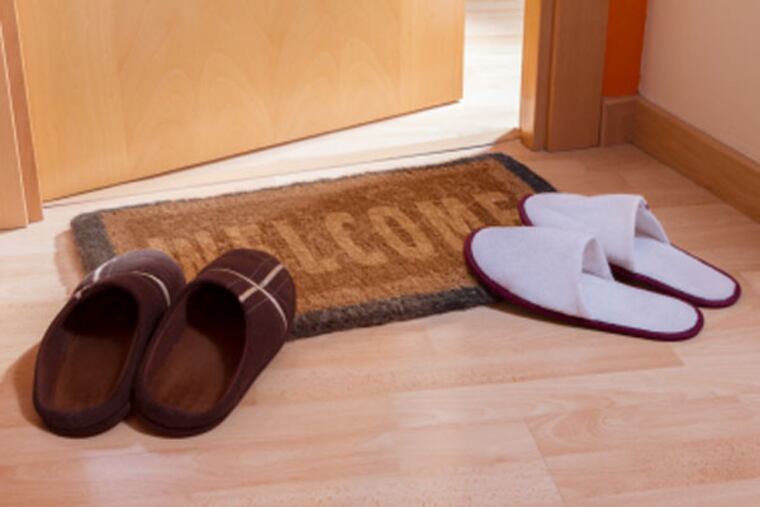GreenSpace: Leaving shoes, and toxins, at the door
The first time I went to my friends' house and they asked me to leave my shoes at the door, I thought it was a little odd.

The first time I went to my friends' house and they asked me to leave my shoes at the door, I thought it was a little odd.
Even excessive.
I spent the evening trampling the hem of my slacks and worrying I'd wind up with a splinter in my foot.
Now, however, I get it.
My friends were just trying to keep bad things out of their house - and more to the point, away from their toddlers. They didn't want the stuff I might be tracking in on my shoes.
Not just run-of-the-mill dirt, chewing gum, and pet waste, but also road oil, heavy metals, pesticides, and more, including what some rather vividly refer to as "garbage juice."
Ewww.
But how much do we actually track in? And how bad is it?
For answers, I went to Drexel University's Michael Waring, who leads the College of Engineering's Indoor Environment Research Group.
He'd looked up a few studies, and one that stood out tallied airborne levels of 32 pesticides and "pesticide degradation products" inside and outside homes in Florida and Massachusetts.
"Indoor concentrations were 5 to 10 times higher than outdoors, even for pesticides that were not sprayed indoors," Waring said, suggesting shoes as a dominant transmission route.
Researchers tested the carpeting in some of the homes and found familiar pesticide nasties, including dieldrin, chlordane, and atrazine.
Pesticides are a particular problem because they are, for lack of a better word, "sticky," Waring said. They're designed to stay on surfaces, where they'll do their job.
So if they get on your shoes, and then you track them onto your carpeting, they tend to stay.
Outdoors, ultraviolet light breaks down these compounds. But indoors, Waring said, the chemicals can exist for years.
Consider: DDT was banned in 1972. But a study looking at carpet dust in Midwestern homes 20 years later found it in a quarter of them.
Another study a few years later showed people who walked on pesticide-treated lawns can pick up the chemicals a week after application.
All of this becomes even more important for people who have infants and toddlers. Children spend a lot of time on the floor. And they frequently put their hands in their mouths, ingesting about 100 milligrams of dust a day.
"They end up being the ones that are truly exposed to all these pollutants being tracked in," Waring said.
Is there actual harm?
"That's definitely hard to parse out," Waring said. "Your baby is not going to eat house dust and likely have an immediate issue." But that doesn't change the fact that many of the things we track in have negative effects on human health, he added.
They can range from developmental delays to generally less well-being to impacts at the end of life.
"The question I would ask is not whether we can prove all of these things are bad," Waring said. "What I would like to counter is: Why not change these things that are likely to have negative effects? It's easy to take your shoes off."
Gauging from some mommy-oriented blog posts, the matter of footwear removal is becoming an etiquette conundrum - "the great shoe debate."
Do you let people know ahead of time so they can plan? What if people wind up going barefoot, possibly spreading athlete's foot fungus on your floor? If you provide slippers, is the recipient going to be grossed out, wondering who wore them last?
And think of poor Carrie in one episode of Sex and the City. She's asked to take off her shoes - her $485 Manolos - and they go missing.
As for Waring, who has no children, he walks straight to his closet and leaves his shoes there, he said. "I do not wear shoes in the house."
215-854-5147 @sbauers